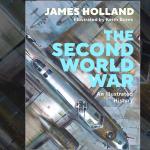James Holland, The Second World War: An Illustrated History
The Second World WarA global war that lasted from 1939 until 1945.: An Illustrated History is a collaborativeProduced by or involving two or more parties working together. effort between bestselling historian James Holland and award-winning aviation artist Keith Burns, aimed at providing a complete history of the Second World War in a concise, engaging, and accessible format. Based on the work undertaken by the pair for the Ladybird Experts series, the Illustrated History brings all 12 of these small volumes together in one place, to create a comprehensive whole. Written primarily for those with a general interest in its history, but who perhaps aren't always inclined to pick up a book on the subject, along with students studying the war at secondary school level, it is intended to provide a thorough grounding and eye-catching introduction to this decisive episode of world history.

There are always concerns with books of this nature. One is that the writing and the content will be too simplistic, 'dumbed-down' to a pedestrian, plodding monotony. Another is the risk that the content is reduced to nothing more than a glorified timeline. After all, the Second World War is an enormous, complex subject – extending to Western and Eastern arenas, the oceans and the air – and to incorporate all of its myriadCountless or very large number. aspects into a little over 300 pages (or 150 pages if one excludes the illustrations) is ambitious to say the least. To do so in a manner that keeps the reader's attention, to entertain as well as educate, is positively Herculean.
Yet remarkably, this is exactly what Holland achieves. The history, while being whistle-stop, reads like an epic. All of the reasons why Holland is a bestselling author are still here, in spades. The narrativeA story; in the writing of history it usually describes an approach that favours story over analysis. voice is strong and keeps the pace and action alive, providing compelling commentary and absorbing anecdotes, constructing three-dimensional characters within a few short sentences. The war itself becomes something tangible, a fully immersive experience where the reader is transported to the mosquito-infested, stinking, dripping jungles of Burma, or to the arid, baked expanses of the North African desert. We become those men, fearing for their lives, often hungry, often ill, always uncomfortable, swatting away flies or blinking the dust out of eyes. And although Holland has said in interview that 'there's not much human drama in it, it's just saying what happened', the number of human stories included, as told through oral histories, diary entries and letters, is impressive. https://www.gethistory.co.uk/news/james-holland-in-conversation The book is not just a synopsis, but a 'proper' history, with original research and evidence-based opinion.
https://www.gethistory.co.uk/news/james-holland-in-conversation The book is not just a synopsis, but a 'proper' history, with original research and evidence-based opinion.
The only, inescapable, issue is that because of the need to shoehorn six years of intense history into so few pages, some things have to be missed or touched on in very narrow detail: I would like to have seen more on the SOESpecial Operations Executive was a secret British espionage, sabotage, and reconnaissance unit working in occupied territory during the Second World War., for example, while the war in the Balkans is only briefly mentioned. And despite devoting space to the other Allies, the book is somewhat Anglocentric. The beauty, however, is that we know Holland has written full-length books on seemingly every aspect of the war in the West, as well as in Burma. There is no doubt that anyone who reads this, who hasn't read his previous works, will next turn to Holland's individual histories. It's an effective marketing strategy.

But this is only half of the book, for Holland's words are beautifully complemented by Burns's pictures. In an approach almost reminiscent of what Fabian Perez labels 'Neo Emotionalism', with dramatic narratives and heady atmospheres behind each painting, there is a sense of movement, of energy, and of reality that is often missing from the standard black-and-white photography that usually illustrates such histories. Although not photorealistic, battles, landscapes and portraits have life, a vitality brought out by clever use of light and shade and by a surprising yet skilful use of colour. These tell a concurrent story, equally as strong, providing visual interest as well as imaginative guides to Holland’s narrative.
Both sides of the book – the written and the drawn – independently are stunning. But together they create something greater: a comprehensive yet fast-paced and gripping insight into the Second World War. This illustrated history ticks every box. For the reasonably uninitiated, there is enough explanation, enough references to films and TV series, and enough action to make the book not just accessible, but riveting. For those familiar with the Second World War, Holland’s style, his arguments and his anecdotes, along with the exquisite illustrations of Burns, make The Second World War: An Illustrated History an absolute pleasure to read.
- Log in to post comments







